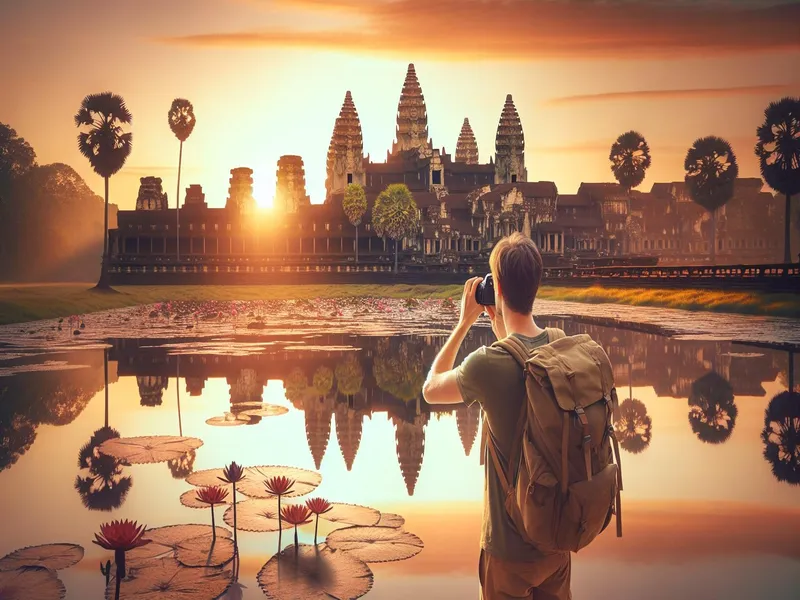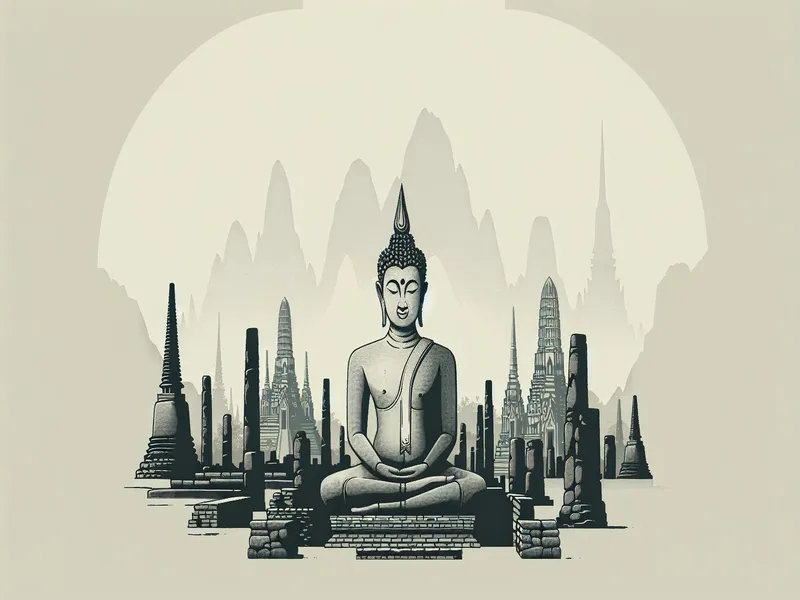
Whether you’re exploring ancient temples in Cambodia or walking along the Great Wall of China, there’s something profoundly enriching about experiencing these historical treasures firsthand.
Ignoring the call of Asia’s historical sites means missing out on an unparalleled journey through time. You risk never fully understanding the intricate world of human civilization that has shaped our world today. This can leave a gap in your travel experiences, making them feel incomplete.
Having explored many of these incredible destinations myself, I can confidently guide you through Asia’s must-visit historical landmarks. My insights will help you make informed choices about where to go and what to see, ensuring a fulfilling adventure.
This guide caters to all types of travelers—from solo adventurers seeking hidden gems to families wanting educational trips for their kids. Everyone will find something valuable here.
I understand how overwhelming it can be to plan such a trip. That’s why I’m here—to offer my expertise and ensure your journey is as smooth and rewarding as possible. For more travel activities that complement your historical explorations, check out this comprehensive resource on travel activities.
The Allure Of History Travel In Asia
Imagine stepping into a time machine and landing in ancient Asia. That’s what history travel feels like, and it’s incredibly captivating. From the mystic temples of Angkor Wat in Cambodia to China’s legendary Great Wall, there’s something for every history buff here.
Ancient Temples
You can’t talk about historical sites in Asia without mentioning temples. I’ve stood before the towering spires of Angkor Wat, feeling like Indiana Jones on an adventure. These temples aren’t just old buildings; they’re stories etched in stone. For example:
- Angkor Wat, Cambodia: Built in the early 12th century as a Hindu temple, later transformed into a Buddhist site.
- Borobudur, Indonesia: This massive 9th-century Mahayana Buddhist temple is adorned with over 2,600 relief panels.
Majestic Walls And Fortresses
Ever wondered what it feels like to walk on walls that have witnessed centuries of history? I did exactly that on the Great Wall of China. It’s not just a wall; it’s an architectural marvel spanning over 13,000 miles.
- The Great Wall Of China: Originally built to protect against invasions from nomadic tribes.
- Gyeongbokgung Palace, South Korea: A grand palace that served as the main royal residence during the Joseon dynasty.
Bustling Markets And Trade Routes
Asia’s historical allure extends beyond monuments. Picture yourself wandering through bustling markets where traders once exchanged spices and silk along ancient routes like the Silk Road.
- Silk Road: Stretched from China to Europe, facilitating trade and cultural exchanges.
- Samarkand Marketplaces (Uzbekistan): Ancient hubs teeming with life and goods even today.
Real-Life Anecdote
Last year during my trip to Japan, I visited Kyoto’s Fushimi Inari Shrine. Walking through those endless red torii gates felt surreal—like entering another dimension. It was both spiritual and visually stunning.
History travel in Asia isn’t just about seeing old things; it’s about experiencing them firsthand. Whether you’re exploring crumbling ruins or well-preserved relics, each site offers a unique window into our shared past.
Top Historical Destinations

Exploring Asia’s historical destinations is like opening a time capsule. Let’s jump into some of the must-visit spots.
Exploring Ancient Temples of Angkor Wat, Cambodia
Angkor Wat in Cambodia feels like stepping into an ancient world. These temples aren’t just ruins; they’re masterpieces of Khmer architecture. Imagine standing before intricate carvings that depict Hindu mythology and grand stone towers rising amidst lush greenery. I remember my first visit—watching the sunrise behind Angkor Wat was surreal. You can’t help but feel a connection to history here, surrounded by centuries-old structures and stories etched in stone.
The Great Wall of China: A Journey Through Time
The Great Wall of China stretches over 13,000 miles, weaving through mountains and deserts. Walking along this wall gives you a sense of the immense effort it took to build it over several dynasties. It’s not just a wall; it’s a testament to human perseverance and ingenuity. Picture yourself trekking up steep steps with panoramic views unfolding around you—it’s both awe-inspiring and humbling. When I visited, I felt like I was walking alongside ancient soldiers who once stood guard there.
Kyoto’s Timeless Temples and Shrines, Japan
Kyoto is home to some of Japan’s most iconic temples and shrines. Places like Fushimi Inari Shrine with its thousands of red torii gates or Kinkaku-ji (Golden Pavilion) are not only visually stunning but spiritually enriching too. Strolling through these sites offers peace amid beauty—perfect for reflection or photography enthusiasts looking for that perfect shot! During my trip to Kyoto, wandering through bamboo groves leading up to serene shrines felt almost otherworldly—a blend of natural tranquility and architectural elegance that’s hard to find elsewhere.
Summarizing:
- Angkor Wat: Intricate carvings, towering structures.
- Great Wall: Massive scale, historical significance.
- Kyoto: Spiritual serenity, visual splendor.
Each destination provides unique insights into Asia’s rich past while offering unforgettable experiences today.
Southeast Asia’s Historical Treasures

Exploring Southeast Asia is like opening a treasure chest of history. You’ll find ruins, ancient cities, and temples that tell stories from centuries ago.
The Majestic Ruins of Ayutthaya, Thailand
Ayutthaya’s ruins are absolutely stunning. Once the capital of the Kingdom of Siam until the late 18th century, it was a bustling city full of grandeur. Walking among its well-preserved structures feels like stepping back in time. Massive stone Buddha statues and intricate temple spires dominate the world. If you love history, you’ll be mesmerized by Wat Phra Si Sanphet and Wat Mahathat—two key sites that epitomize Ayutthaya’s former glory.
Historic Hoi An: A Blend of Cultures, Vietnam
Hoi An is a gem in Vietnam where cultures blend seamlessly. This port town became a melting pot due to its strategic trading position between the 15th and 19th centuries. As you stroll through its lantern-lit streets, you’ll see Chinese temples next to French colonial buildings and Japanese merchant houses. The Old Town area is a UNESCO World Heritage site that’s perfect for anyone who enjoys seeing how different cultures influence architecture and daily life.
Borobudur Temple: A Buddhist Monument, Indonesia
Borobudur Temple in Indonesia leaves everyone awestruck with its sheer size and intricate details. Built in the 9th century during the reign of the Sailendra Dynasty, it’s one of the largest Buddhist monuments in the world. Imagine climbing up its nine stacked platforms—six square and three circular—to reach its central dome surrounded by 72 Buddha statues seated inside perforated stupas (dome-shaped structures). Each step offers panoramic views that make you feel connected to something greater than yourself.
In each destination within Southeast Asia’s historical treasures lies an experience that not only educates but transforms your understanding of our shared human past.
South Asia’s Rich Heritage
Exploring South Asia’s history feels like stepping into a living museum. From India to Sri Lanka, every corner is bursting with stories waiting to be discovered.
The Mughal Magnificence of Taj Mahal, India
The Taj Mahal isn’t just a building; it’s a love story etched in marble. Standing before its gleaming white domes and minarets, you can’t help but feel the romance that inspired its creation. Shah Jahan built this architectural marvel as a mausoleum for his beloved wife Mumtaz Mahal. Intricate carvings and precious stone inlays adorn the facade, making it an icon of Mughal architecture. Imagine walking through the gardens at sunrise when the first light casts a pink hue on the monument—it’s magical.
Sri Lanka’s Ancient Cities: Anuradhapura and Polonnaruwa
Sri Lanka offers more than stunning beaches; its ancient cities are time capsules of history. In Anuradhapura, massive stupas (Buddhist relic mounds) dominate the skyline, each telling tales from centuries past. You can almost hear whispers of monks chanting prayers in these hallowed grounds. Polonnaruwa, another gem, showcases majestic ruins set against lush landscapes. Here, I felt like Indiana Jones discovering hidden treasures among stone temples and statues that have stood for over 800 years.
Exploring these places isn’t just about seeing old stones; it’s about immersing yourself in their stories and feeling connected to something much larger than ourselves.
East Asia’s Historical Masterpieces
Traveling through East Asia feels like stepping into a living history book. The region brims with intricate stories and landmarks that reveal the richness of its past.
Discovering the Ancient Korean Kingdoms
When I first walked through Gyeongbokgung Palace in Seoul, it felt like time-traveling to the era of Joseon kings. South Korea boasts ancient kingdoms like Silla, Goguryeo, and Baekje. Each kingdom left behind fascinating relics.
- Gyeongju: Known as “the museum without walls,” it’s home to Bulguksa Temple and Seokguram Grotto.
- Baekje Historic Areas: These sites include fortresses and royal tombs that tell tales of old dynasties.
Walking through these places, you can almost hear whispers from the past. You might even spot locals dressed in traditional hanbok attire—it’s a unique way to experience history!
Taiwan’s Blend of Indigenous and Colonial History
Taiwan blends indigenous culture with layers of colonial influence. When I visited Tainan, the oldest city on the island, I discovered a world of Dutch forts mingling with Chinese temples.
- Fort Zeelandia (Anping Fort): Built by the Dutch in 1624; it’s an excellent spot for history buffs.
- Lungshan Temple: A beautiful mix of Fujianese architecture combined with local craftsmanship.
Historical Travel Tips and Recommendations
You’re in for a treat if you’re planning a historical trip to Asia. The continent’s rich world of cultures, traditions, and ancient wonders offers endless exploration opportunities.
Best Times To Visit
Timing your visit right can make all the difference. Most historical sites in Asia are best visited during the shoulder seasons—spring (March to May) and fall (September to November). During these periods, you’ll avoid the extreme temperatures of summer and the heavy rains of monsoon season. For instance, Angkor Wat’s weather is most pleasant from November to March when it’s cooler but still dry.
I remember my visit to Kyoto during cherry blossom season in April; the temples looked ethereal surrounded by blooming sakura trees. If crowds bug you, consider visiting popular spots like the Great Wall or Taj Mahal early in the morning or late afternoon for fewer tourists and better light for photos.
How To Respect Local Cultures and Traditions
Respecting local customs is key when traveling through historical sites in Asia. Each culture has its own set of etiquettes that visitors should follow. In many temples across Thailand, Cambodia, and Japan, it’s customary to remove shoes before entering sacred areas. I once almost walked into a shrine with my shoes on—it was an honest mistake but easily avoided if you’re mindful.
- Dress modestly: Cover shoulders and knees at religious sites.
- Use both hands: When giving or receiving items like money or gifts.
- Learn basic phrases: Simple greetings in the local language show respect.
Imagine walking into someone’s home uninvited; that’s how locals might feel if customs aren’t observed at their sacred sites. Showing appreciation for their heritage enriches your travel experience tenfold while ensuring these treasures remain respected for future generations.
To Sum Up
Exploring Asia’s historical sites is more than just a journey through time; it’s an opportunity to immerse yourself in the rich world of human civilization. From the majestic ruins of Angkor Wat to the spiritual serenity of Kyoto, each destination offers unique experiences that are both educational and deeply moving.
Traveling through these ancient landscapes allows us to connect with cultures and traditions that have shaped our world. By planning thoughtfully and respecting local customs, we can fully appreciate the profound impact these historical treasures have on our understanding of history and ourselves.
Asia’s historical wonders await those ready to begin on a transformative journey filled with awe-inspiring moments and lasting memories.